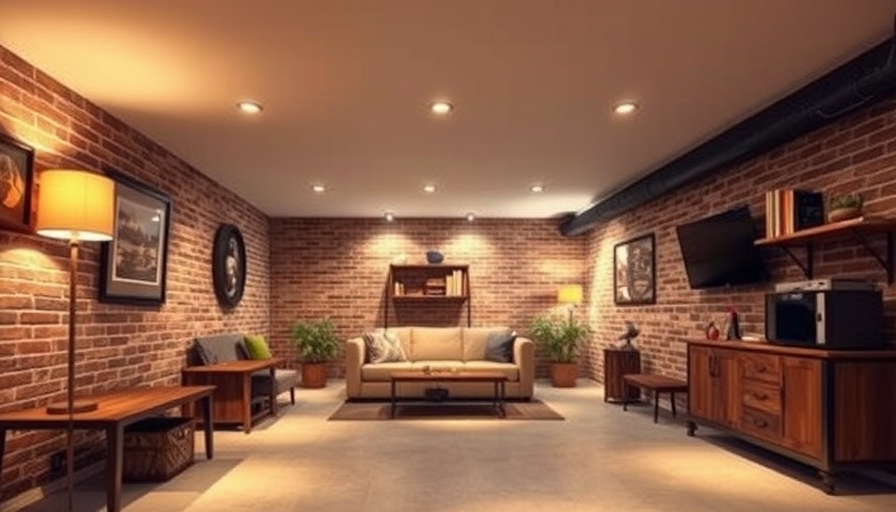
Transforming Darkness into Light: The Vital Role of Lighting
Basements, particularly in Brooklyn, can often feel like an extension of the underworld, lacking natural light and inviting warmth. Homeowners are increasingly discovering that effective lighting isn’t just about visibility; it's the magic ingredient that turns an unused storage area into a vibrant part of the home. The way we light a basement is crucial, impacting its mood and practicality. The good news? With clever strategies, your basement can shed the gloom and become a welcoming oasis.
The Essentials of Basement Lighting Design
Before plunging into specific lighting options, understanding the fundamentals of basement lighting design is essential. Many basements have limited natural light due to their underground nature. Consequently, this necessitates a strategic approach to artificial lighting that aligns with the intended function of the space. For instance, if your basement serves as a cozy retreat, softer, warmer lights will create a sanctuary feel. Conversely, brighter lighting is key for spaces such as gyms or home offices.
The Best Types of Lighting: A Layered Approach
A successful lighting scheme typically involves a layered approach, incorporating three main types of lighting: ambient, task, and accent. Ambient lighting is your foundational illumination, encompassing fixtures like recessed lights or ceiling-mounted options that fill the room evenly. Task lighting shines in work zones or reading nooks, making it easier to see when you’re flicking through a book or engaged in work. Each layer works together to contribute to a well-lit and dynamic atmosphere.
Innovative Lighting Solutions for Small Basements
For those wrestling with small basements, achieving openness can feel daunting. Thankfully, creative lighting solutions can work wonders. Wall sconces are a perfect example. They occupy minimal floor space while delivering soft, diffused illumination. Additionally, strategically placed mirrors can amplify light and make the room appear larger by creating a depth effect.
LED Lighting: The Sustainable Choice
In recent times, there's been a growing trend among Brooklyn homeowners to embrace energy-efficient solutions in their basements. Enter LED lights: these energy-saving powerhouses are not only budget-friendly by reducing electricity costs, but they also last longer than traditional bulbs. You can enjoy extensive color temperature options with LEDs, allowing you to adjust the atmosphere from warm and inviting to cool and crisp.
Top Recommended Fixtures: What to Use
When it comes to fixtures, you have an array of options catering to your basement's needs. Whether you're after a chic pendant light over a bar area, or recessed lighting for maximum functionality, it's crucial to find fixtures that supplement your space's aesthetic. Incorporate a mix of bold statement pieces, like decorative chandeliers, alongside functional lighting to create visual interest.
Color Temperature: Setting the Mood
The color temperature of your lighting significantly shapes the ambiance of your basement. For an alluring cozy feel, warm whites (ranging from 2700K to 3000K) should be your go-to. Conversely, cooler temperatures (4000K to 5000K) promote alertness and focus, making them perfect for workspaces or workout areas.
Smart Lighting: The Future of Illumination
Today's technology allows for the convenience of smart lighting systems that you can control from your smartphone. Imagine adjusting your basement's brightness or color temperature from anywhere, creating the perfect environment for movie nights or social gatherings with mere taps on your device. This is more than just a trend; it’s the future of home comfort.
Overcoming Common Basement Lighting Mistakes
While many are eager to enhance their basement lighting, pitfalls abound. One common misconception is that only overhead lighting is necessary. However, layering diverse types of lighting adds depth and dimension. Furthermore, using only bright white lights can lead to an overwhelming atmosphere. Consider mixing soft tones and incorporating dimmers to enhance versatility.
Final Thoughts: Illuminate Your Basement Oasis Today!
Lighting is more than just illumination; it’s the key to unlocking the potential of your basement. Armed with thoughtful techniques and recommendations, you can breathe life into those hidden corners of your home. As you embark on your lighting journey, don't overlook the array of lighting and insulation upgrades available to create a beautiful and functional space. Start envisioning how your basement can transform into not just a room, but a cherished part of your home!
 Add Row
Add Row  Add
Add 




Write A Comment